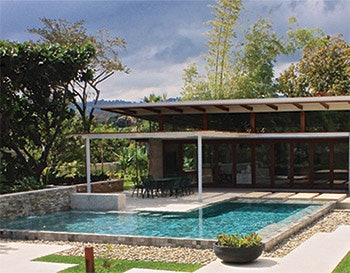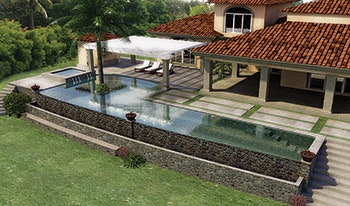
Designer and builder Joan Roca has earned a reputation as arguably the most prominent aquatic artist in Costa Rica, where he has created some of the most beautiful residential and commercial pool settings found anywhere in the world. In recent years, Roca has expanded his reach into neighboring Nicaragua, a campaign that has led him to work for some of the nation’s wealthiest and most prominent citizens.
Success in the aquatic design industry often means having to step outside your comfort zone. At least that’s been the case for me.
I’ve worked in the Costa Rican pool and spa industry since my youth, but it wasn’t until 12 years ago when I took my first Genesis 3 class that I realized that for me to achieve more on a professional level, I needed to dramatically expand my design expertise. It was a revelation that changed my life.
I’ve since designed and installed numerous custom projects that I’m proud to say are worthy of their beautiful settings and satisfying to my often-discerning clients. None of that would have been possible had I not started down an entirely new and unknown path.
More recently, I stretched myself again by expanding operations outside of the comfortable confines of Costa Rica into Nicaragua. Although this new market is relatively close by geographically, the two are different in many ways.
LANDS OF CONTRAST
Nicaragua is largely undeveloped, a place where there is virtually no middle class and very few foreign residents and investors. And in the not-so-distant past, it was politically unstable. Because of all that there is very little infrastructure outside the major towns and cities.
In stark contrast, my home country of Costa Rica has both a very large middle class and well-established population of U.S. citizens. That’s made for a country that has enjoyed a relatively strong economy. It’s very peaceful and politically stable.
I believe Nicaragua is headed in the same direction, but it has a long way to go to reach Costa Rica’s level of economic development. It does, however, have a small yet extremely wealthy upper class. Their large, full-time staffs care for some of the most beautiful homes found anywhere in the world, amongst areas of extreme poverty.
Because of these conditions, I have naturally focused my efforts entirely on those people who can afford luxury environments. As a result, I’ve now done projects for some of Nicaragua’s most fortunate and prominent homeowners. The project featured here is one of those.
PRIME REFERRALS
One thing that has been consistent wherever I’ve worked (at least since my transition into custom design and construction) is that I work almost exclusively on referrals. In fact, every project I’ve done in Nicaragua has come by way of a happy client suggesting to family, friends or associates that I design and build their aquatic spaces.



That was the case for this project, a referral client who is widely known as the wealthiest man in the country. He owns multiple companies and properties while enjoying a life of both fame and fortune. One of his properties is a huge farm, more than 1,000 acres, where he’s currently building a private hunting reserve. Instead of hunting live animals, he has hired a specialist to develop mechanical animals. I’m currently working on the pools and spas for the lodge where the client will house his guests.
This property is located in a wealthy area in Managua City, the country’s capitol. The project is situated between the main house and a new contemporary guest/pool house. It’s very much a residential pool in terms of size and scope, but fitted a number of fine details.
CONTEMPORARY CLASS
I was brought in to design a pool that harmonized with the beautiful contemporary architecture of the pool house. The design scheme was entirely rectilinear with a perimeter overflow on the house and deck side and a two-sided raised overflow edge on the far side.
The pool house features floor-to-ceiling windows, which create a feeling of connection to the beautifully lush surrounding landscape. The clients liked the idea of locating the pool near the windows and around two sides of the deck to create the feeling of being close to the water. That effect is enhanced by the deck-level slot overflow, which creates a seamless visual transition between the hardscape and water surface.
To further enhance the intimate proximity to the water, they wanted to be able to walk across the water to get to the terraced patio. This is why we included a shallow reflecting pool area off to one side of the main pool with stepping pads that appear to float on the water’s surface.
The clients also wanted the soothing sound of moving water, which we generate with both the overflow details and a laminar sheet of water that falls from a raised wall that borders one end of the pool near the deck.
Away from the home, the pool is raised eight inches above grade with water flowing over a wide, 10-inch edge down into a bed of cobble and then into a collection plumbing loop. Both the slot overflow and outer edge flow into a surge tank that is buried beneath the equipment pad behind the house.
The surface of the reflecting pool is 10 inches lower than that of the main pool area. On either side of the steps that cross the pool, water flows from the main pool down into the reflecting pool. This also contributes to the sound of moving water and provides a subtle, yet interesting vertical transition as you move across the stepping pads.
Although the design is visually simple and elegant, the hydraulics and construction were tricky. We worked to extremely tight tolerances to ensure that all of the edges could be wetted with a minimal amount of water. The system is designed to provide 116 to 18 inch of water over all the edges. I always use a water level and also in this case polish the stone to achieve a near precise level edge.
Even though this design is one of my favorites I’ve done over the years, it’s far from the largest. The main pool area measures a modest 732 square feet. The reflecting pool area is 226 square feet. The system contains 18,000 gallons. The pool has two depths, 4 feet, 8 inches transitioning to 3 feet, 4 inches. There is also a 6-inch deep tanning shelf. The reflecting pool area is 10 inches deep.
The pool shell is constructed entirely of concrete block. In fact, all of my pools are built with block because of the lack of gunite or shotcrete crews in Costa Rica and Nicaragua.
RICH DETAILS
As is true of almost all projects, the materials selections were key to the success of the design. On the decks, stepping pads and modular pathways that surround the pool, we used a beautiful Coralina stone. It’s an expensive material that requires a great deal of care because it’s soft and porous.
The material is beautifully colored with light shades of cream and beige. Despite the maintenance concerns, it’s great for decks because it stays very cool, which is a big issue in such a warm and sunny climate. It does need to be sealed and cleaned regularly to avoid deterioration and prevent mold build up.
The inside of the pool is finished entirely with a far more durable quartz material cut into 4-inch tiles. There’s a raised wall running down one side of the pool, the only section without a perimeter overflow. It’s finished in a ledger stone that is different than the quartz or Coralina but matches in color.
I love working with these natural materials because of the richness of subtle colors and the fact that no two pieces look exactly the same. It’s a wonderful complement to the geometric lines, softening the lines with the natural variations in color and texture.
In this project, I used the different materials to define the visual transition between the water and dry surfaces. The decking material goes right to the water’s edge while the stone inside the water runs right up to the water’s surface. Aside from splash out when people are in the pool, no stone on the deck touches the water and no stone in the pool comes onto the deck.

In the reflecting pond we have five stepping pads that go in one direction and three in another at a right angle. The pads are all slightly cantilevered from their bases to create the floating effect.
The steps inside the main pool area are configured down the length of the pool by the deck. I credit this detail to my friend David Tisherman, who often uses similar step treatments. I use these types of steps on almost every project. They provide easy entry and egress down the length of the pool, while providing places to sit at varying depths, and they don’t take up much room inside the pool compared to more standard step configurations. It’s very functional.
Overall, I’m very proud of this project for the way it fits the luxurious setting and meets all the clients’ desires. I’m also very happy that my business has found its way into this beautiful country where I’ve been given the opportunity to create such wonderful settings.
Equipment Ease
Although the hydraulic system was fairly complex due to the edge effects and elevation changes, the equipment we needed to operate the pool is fairly simple.
We have two Pentair Whisperflo pumps, one driving the edge effects, the other handling overall circulation. The edge system draws water from the surge tank and returns it to inlets mounted on the walls near the pool floor. Water drawn from the split main drain is returned near the surface. This way we’re achieving consistent circulation from top to bottom.
We talked about using VSP technology, but the owner wasn’t concerned about power usage because it’s affordable in the region and this system, which doesn’t include a spa, doesn’t have the different operating scenarios that often justify the added expense.
We used a single cartridge filter, also by Pentair. (All of the equipment on this project is from Pentair.) I like cartridge filters because they don’t use water in backwashing, provide good water quality and in a setting with full-time maintenance staff, routine cleaning isn’t a problem. The pool is sanitized using a saltwater chlorination system.
The pool is lit with LED lights, while the steps in the reflecting pool are lit on each side using fiber optics, which highlights the steps at night with a soft glow. The laminar flow fixture on the raised wall is also lit with fiber optics.
The pool is not heated; in this climate you can swim comfortably year round.
Comments or thoughts on this article? Please e-mail [email protected].











































